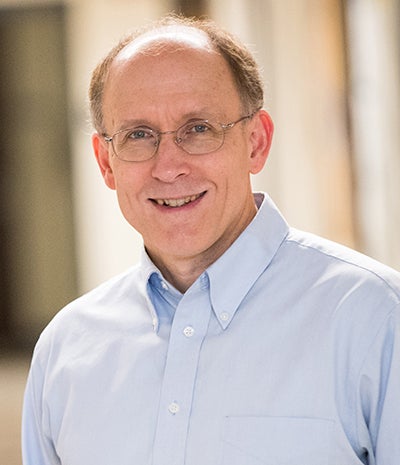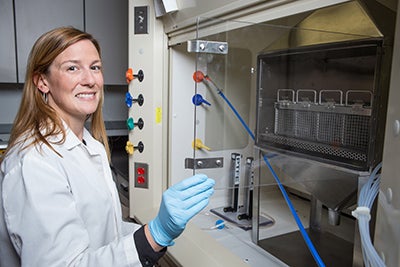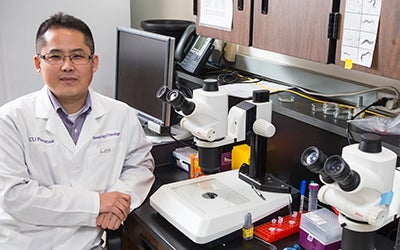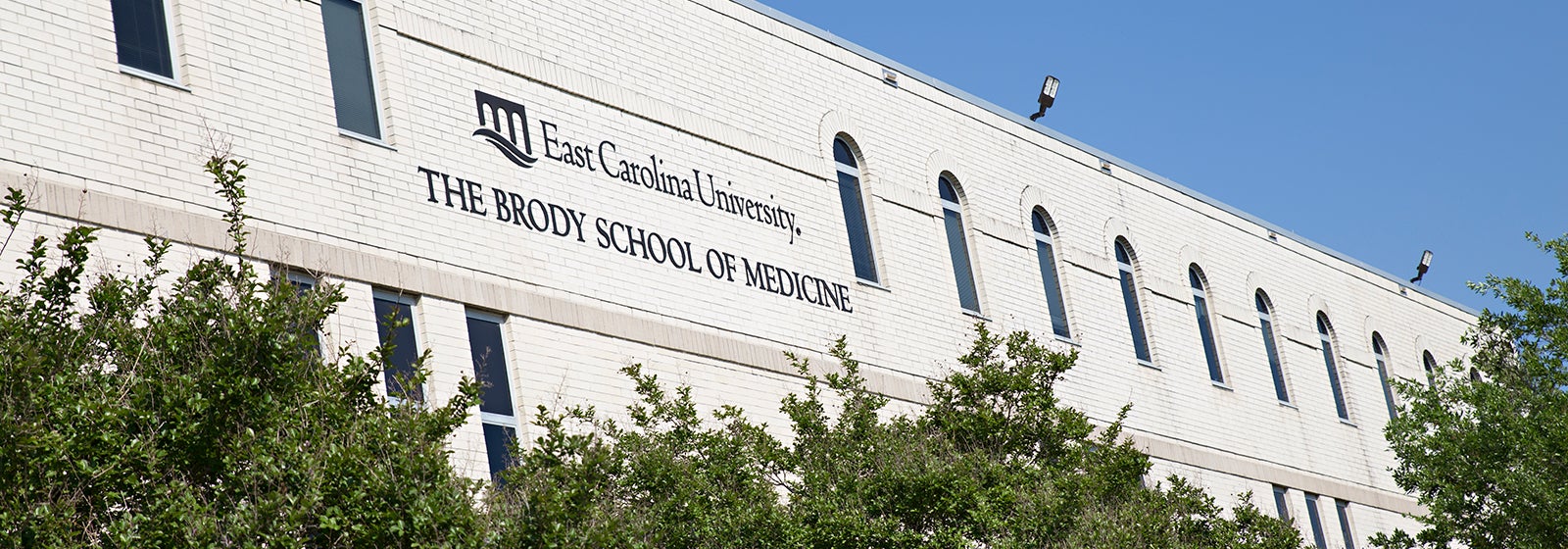FINDING A CURE
New Brody Brothers grants push ECU researchers toward medical breakthroughs
Every day, ECU’s Brody School of Medicine teems with professors and students pipetting cell cultures, analyzing tissues and eyeballing microscopes in the name of cutting-edge research.
The Brody Brothers Foundation Endowment Fund aims to reward such diligence with grants that allow them to continue their projects and make discoveries.
The Brody Brothers committee approved $254,426 this academic year to be divided among seven grant proposals. Research topics to earn funding include cancer, multiple sclerosis and peripheral arterial disease.
The foundation was established in 1999 when the Brody family of eastern North Carolina donated $7 million to fund research projects at the medical school. Since awarding its first grants in 2005, “Brody Brothers” research funding has provided more than $1.1 million over time to support work related to diseases that most impact the lives of North Carolinians.
“We are very grateful to the members of the Brody family for their support of the research and educational missions of the Brody School of Medicine,” said Dr. Russ Price, associate dean for research and graduate studies. “Data generated by these funded studies have helped a number of our faculty compete successfully for higher level national grants from the National Institutes of Health, National Science Foundation, Department of Defense and other major national foundations like the American Heart Association. In the recent funding climate, a resource like the Brody Brothers has been invaluable in sustaining the research mission of our medical school.”
Here are a few of this year’s project winners:
Finding a cure for multiple sclerosis
Dr. Mark Mannie has been researching multiple sclerosis since the 1980s and says finding a cure has been a lifelong pursuit.

Dr. Mark Mannie, a professor in the Department of Microbiology and Immunology, will use his Brody Brothers grant to search for a cure for multiple sclerosis. (Photos by Cliff Hollis)
As a professor in the Department of Microbiology and Immunology, his work involves creating and studying a vaccine that delivers targeted therapies for autoimmune diseases like MS.
MS is a disease of the central nervous system in which the body’s immune system incorrectly attacks healthy tissue in the brain, spinal cord and optic nerves, causing symptoms such as blurred vision, loss of balance and paralysis.
In the U.S., the number of people with MS is estimated to be about 400,000, with approximately 10,000 new cases diagnosed every year.
“That is a staggering rate,” Mannie said.
Current treatments for MS are drugs that suppress the body’s autoimmune response, but also unnecessarily suppress its responses to other viruses and bacteria.
Mannie’s vaccine targets just the myelin – the protective covering surrounding the nerves of the central nervous system – that MS interferes with, “and leaves alone all other adaptive immunity that we need to maintain health and well-being,” he said.
The $40,000 Brody Brothers grant that Mannie received will help his team better understand how the vaccine works.
“If you had a car and the engine broke, it would be helpful to know how the engine works in order to fix it,” he said. “The same applies to the vaccines. We know they work really well, but we don’t know why.”
Once the mechanisms of the vaccine are identified, it could be morphed into treatments for other diseases like diabetes and rheumatoid arthritis.
Mannie’s research assistant for the project is Cody Moorman, a fourth-year doctoral student at ECU.
“It’s exciting to be working on something that there is a great need for and that could affect a lot of people,” Moorman said. “It’s nice to know that my project has funding and I’ll be able to do this research well with the materials that I need.”
Mannie said he is optimistic that the vaccine could be ready for clinical trials in several years. He’s also buoyed by the fact that their vaccine is a niche area of immunology research.
“The vaccines that we’ve created are unique to our lab and to ECU,” he said. “What we’re doing here is unique. Nobody else — not Harvard, Stanford, or Johns Hopkins — is doing what we’re doing.”
Fighting the adverse effects of air pollution
Each year, nine million people die prematurely from air pollution-related deaths worldwide. In North Carolina, ozone is the most widespread air quality problem, according to the N.C. Department of Environmental Quality.

Department of Pharmacology and Toxicology Assistant Professor Kymberly Gowdy will use a Brody Brothers grant to study ways to help the lungs heal after air pollution inhalation.
In the Brody School of Medicine’s Department of Pharmacology and Toxicology, assistant professor Kymberly Gowdy is researching ways to prevent and reduce health problems associated with ozone pollution.
While ozone high in the atmosphere protects the Earth from harmful solar radiation, near the ground it is unhealthy to breathe, particularly among children; people with asthma and other respiratory ailments; and people who work or exercise vigorously outdoors. Ground-level ozone is created by emissions from industrial facilities, motor vehicle exhaust and gasoline vapors.
“The sickness you see after air pollution exposure is caused by cells dying (in the lungs). Immune cells then come in and try to make the lungs better,” Gowdy said. “We’re trying to see how those cells get activated and deactivated.”
Specifically, Gowdy and postdoctoral scholar Brita Kilburg-Basnyat are looking at lipids in the lungs and how they can help the lungs recover after inhaling pollution. They’ve found that supplementing the diet with docosahexaenoic acid (DHA) can help the body create those good lipids. DHA is an omega-3 fatty acid found in supplements like fish oil.
“The really cool thing about DHA is it’s not an injection or medical pill, it’s a really easy alteration people can make to their diet,” Kilburg-Basnyat said.
She and Gowdy plan to use their Brody Brothers grant of $37,735 and apply for a larger grant within the next six months.
“Our hope is to take this smaller grant and turn it into a multi-million dollar grant that we can bring to the university, which will not only allow me to expand my research program, but to expand some of the toxicology that’s happening here,” Gowdy said.
Using regenerative medicine to combat osteoporosis
Dr. Myon-Hee Lee, associate professor in the Department of Internal Medicine Hematology/Oncology Division, is no stranger to the Brody Brothers Foundation. He received a grant in 2015 to study stem cell differentiation in a species of nematodes, or roundworms.

Dr. Myon-Hee Lee, associate professor in the Department of Internal Medicine, received the most funding from the Brody Brothers foundation this year with $45,000.
Now, he’s studying stem cell differentiation in human systems. His current project received the most funding this year with $45,000.
Lee’s project uses bone marrow stem cells to study osteoporosis, a bone disease that occurs when the body loses too much bone and becomes susceptible to breaks or fractures. Lee’s mother was hospitalized with osteoporosis symptoms and had to get surgery, which drove him to study the disease.
“I want to help other people like my mom,” he said.
About 54 million Americans have osteoporosis and low bone mass, according to the National Osteoporosis Foundation. Studies suggest that approximately one in two women and up to one in four men age 50 and older will break a bone due to osteoporosis.
Research has also shown that osteoporosis is higher in obese people, Lee said. While osteoporosis typically refers to the body’s bones becoming more porous, some people who are overweight have fat inside their bones that could make them weak and prone to fractures. Lee is looking at the stem cell regulators that tell the body to generate either bone or fat cells, and how to encourage more bone cells to grow.
“We believe our findings will pave the way for developing therapeutic strategies to prevent osteoporosis during obesity or aging,” he said, adding that the applications could be far-reaching for regenerative medicine and eventually applied to myriad other diseases.
